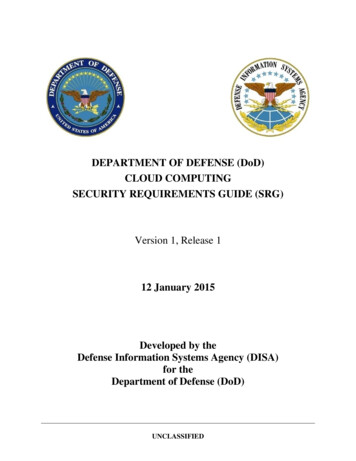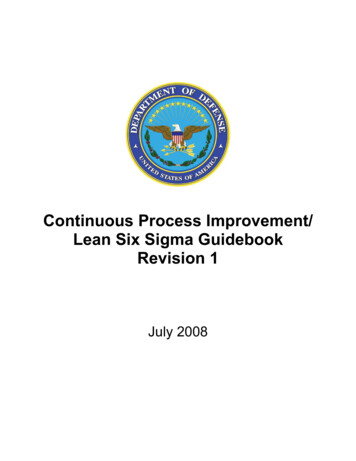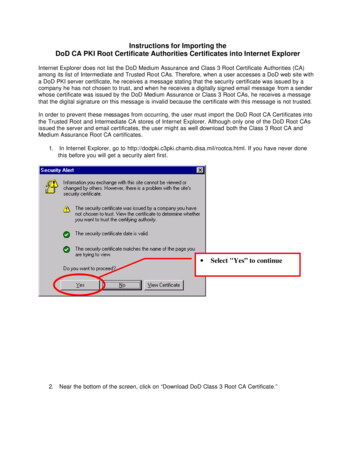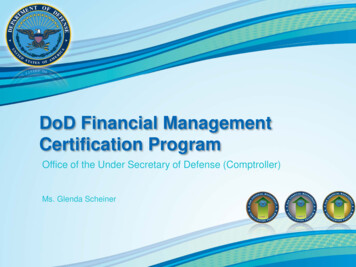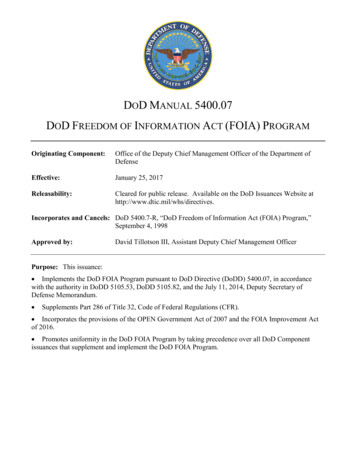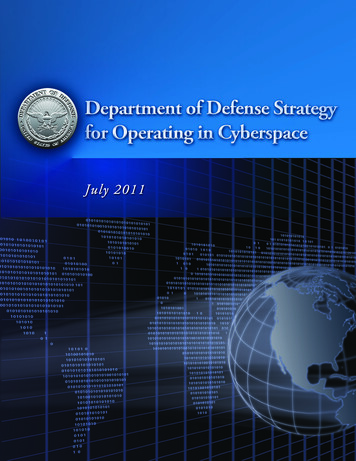
Transcription
DEPARTMENT OF DEFENSE STRATEGYFOR OPERATING IN CYBERSPACEJULY 2011
CONTENTSINTRODUCTION1STRATEGIC CONTEXT2FIVE STRATEGIC INITIATIVESStrategic Initiative 1: Treat cyberspace as an operational domain toorganize, train, and equip so that DoD can take full advantage of cyberspace’spotential5Strategic Initiative 2: Employ new defense operating concepts to protect DoDnetworks and systems6Strategic Initiative 3: Partner with other U.S. government departments andagencies and the private sector to enable a whole-of-government cybersecuritystrategy8Strategic Initiative 4: Build robust relationships with U.S. alliesand international partners to strengthen collective cybersecurity9Strategic Initiative 5: Leverage the nation’s ingenuity throughan exceptional cyber workforce and rapid technological innovationCONCLUSION1013
INTRODUCTION“Cybersecurity threats represent one of the most serious national security, public safety,and economic challenges we face as a nation.”- 2010 National Security StrategyCyberspace is a defining feature of modern life. Individuals and communities worldwideconnect, socialize, and organize themselves in and through cyberspace. From 2000 to 2010,global Internet usage increased from 360 million to over 2 billion people. As Internet usagecontinues to expand, cyberspace will become increasingly woven into the fabric of everyday lifeacross the globe.U.S. and international businesses trade goods and services in cyberspace, moving assets acrossthe globe in seconds. In addition to facilitating trade in other sectors, cyberspace is itself a keysector of the global economy. Cyberspace has become an incubator for new forms ofentrepreneurship, advances in technology, the spread of free speech, and new social networksthat drive our economy and reflect our principles. The security and effective operation of U.S.critical infrastructure – including energy, banking and finance, transportation, communication,and the Defense Industrial Base – rely on cyberspace, industrial control systems, and informationtechnology that may be vulnerable to disruption or exploitation.Along with the rest of the U.S. government, the Department of Defense (DoD) depends oncyberspace to function. It is difficult to overstate this reliance; DoD operates over 15,000networks and seven million computing devices across hundreds of installations in dozens ofcountries around the globe. DoD uses cyberspace to enable its military, intelligence, andbusiness operations, including the movement of personnel and material and the command andcontrol of the full spectrum of military operations.The Department and the nation have vulnerabilities in cyberspace. Our reliance on cyberspacestands in stark contrast to the inadequacy of our cybersecurity – the security of the technologiesthat we use each day. Moreover, the continuing growth of networked systems, devices, andplatforms means that cyberspace is embedded into an increasing number of capabilities uponwhich DoD relies to complete its mission. Today, many foreign nations are working to exploitDoD unclassified and classified networks, and some foreign intelligence organizations havealready acquired the capacity to disrupt elements of DoD’s information infrastructure.Moreover, non-state actors increasingly threaten to penetrate and disrupt DoD networks andsystems. We recognize that there may be malicious activities on DoD networks and systems thatwe have not yet detected.DoD, working with its interagency and international partners, seeks to mitigate the risks posed toU.S. and allied cyberspace capabilities, while protecting and respecting the principles of privacyand civil liberties, free expression, and innovation that have made cyberspace an integral part ofU.S. prosperity and security. How the Department leverages the opportunities of cyberspace,while managing inherent uncertainties and reducing vulnerabilities, will significantly impactU.S. defensive readiness and national security for years to come.Department of Defense Strategy for Operating in Cyberspace1
STRATEGIC CONTEXT“There is no exaggerating our dependence on DoD’s information networks for command andcontrol of our forces, the intelligence and logistics on which they depend, and the weaponstechnologies we develop and field.”- 2010 Quadrennial Defense ReviewDoD’s Strengths and Opportunities in CyberspaceAs does the nation as a whole, DoD relies on a secure and reliable cyberspace that protectsfundamental freedoms, privacy, and the free flow of information. In support of both U.S. corecommitments and national security, DoD has significant strengths and opportunities incyberspace. The U.S. military’s ability to use cyberspace for rapid communication andinformation sharing in support of operations is a critical enabler of DoD missions. Morebroadly, DoD’s depth of knowledge in the global information and communications technologysector, including its cybersecurity expertise, provides the Department with strategic advantagesin cyberspace.The quality of the United States’ human capital and knowledge base in both the public andprivate sectors provides DoD with a strong foundation on which to build current and future cybercapabilities. DoD has played a crucial role in building and leveraging the technological prowessof the U.S. private sector through investments in people, research, and technology. DoD willcontinue to embrace this spirit of entrepreneurship and work in partnership with thesecommunities and institutions to succeed in its future cyberspace activities.Given the dynamism of cyberspace, nations must work together to defend their common interestsand promote security. DoD’s relationship with U.S. allies and international partners provides astrong foundation upon which to further U.S. international cyberspace cooperation. Continuedinternational engagement, collective self-defense, and the establishment of internationalcyberspace norms will also serve to strengthen cyberspace for the benefit of all.Cyber Threats“The very technologies that empower us to lead and create also empower those who woulddisrupt and destroy.”- 2010 National Security StrategyThe Internet was designed to be collaborative, rapidly expandable, and easily adaptable totechnological innovation. Information flow took precedence over content integrity; identityauthentication was less important than connectivity. The Internet’s original designers could nothave imagined the extent of its vital and growing role for DoD and its operations. The globalscope of DoD networks and systems presents adversaries with broad opportunities forexploitation and attack.Department of Defense Strategy for Operating in Cyberspace2
Low barriers to entry for malicious cyber activity, including the widespread availability ofhacking tools, mean that an individual or small group of determined cyber actors can potentiallycause significant damage to both DoD and U.S. national and economic security. Small-scaletechnologies can have an impact disproportionate to their size; potential adversaries do not haveto build expensive weapons systems to pose a significant threat to U.S. national security.In developing its strategy for operating in cyberspace, DoD is focused on a number of centralaspects of the cyber threat; these include external threat actors, insider threats, supply chainvulnerabilities, and threats to DoD‘s operational ability. DoD must address vulnerabilities andthe concerted efforts of both state and non-state actors to gain unauthorized access to itsnetworks and systems.Foreign cyberspace operations against U.S. public and private sector systems are increasing innumber and sophistication. DoD networks are probed millions of times every day, andsuccessful penetrations have led to the loss of thousands of files from U.S. networks and those ofU.S. allies and industry partners. Moreover, this threat continues to evolve as evidence grows ofadversaries focusing on the development of increasingly sophisticated and potentially dangerouscapabilities.The potential for small groups to have an asymmetric impact in cyberspace creates very realincentives for malicious activity. Beyond formal governmental activities, cyber criminals cancontrol botnets with millions of infected hosts. The tools and techniques developed by cybercriminals are increasing in sophistication at an incredible rate, and many of these capabilities canbe purchased cheaply on the Internet. Whether the goal is monetary, access to intellectualproperty, or the disruption of critical DoD systems, the rapidly evolving threat landscapepresents a complex and vital challenge for national and economic security.Some cyber threats also may come from insiders. Malicious insiders may exploit their access atthe behest of foreign governments, terrorist groups, criminal elements, unscrupulous associates,or on their own initiative. Whether malicious insiders are committing espionage, making apolitical statement, or expressing personal disgruntlement, the consequences for DoD, andnational security, can be devastating.Software and hardware are at risk of malicious tampering even before they are integrated into anoperational system. The majority of information technology products used in the United Statesare manufactured and assembled overseas. The reliance of DoD on foreign manufacturing anddevelopment creates challenges in managing risk at points of design, manufacture, service,distribution, and disposal.Potential U.S. adversaries may seek to exploit, disrupt, deny, and degrade the networks andsystems that DoD depends on for its operations. DoD is particularly concerned with three areasof potential adversarial activity: theft or exploitation of data; disruption or denial of access orservice that affects the availability of networks, information, or network-enabled resources; anddestructive action including corruption, manipulation, or direct activity that threatens to destroyor degrade networks or connected systems.Department of Defense Strategy for Operating in Cyberspace3
Cyber threats to U.S. national security go well beyond military targets and affect all aspects ofsociety. Hackers and foreign governments are increasingly able to launch sophisticatedintrusions into the networks and systems that control critical civilian infrastructure. Given theintegrated nature of cyberspace, computer-induced failures of power grids, transportationnetworks, or financial systems could cause massive physical damage and economic disruption.DoD operations—both at home and abroad—are dependent on this critical infrastructure.While the threat to intellectual property is often less visible than the threat to criticalinfrastructure, it may be the most pervasive cyber threat today. Every year, an amount ofintellectual property larger than that contained in the Library of Congress is stolen from networksmaintained by U.S. businesses, universities, and government departments and agencies. Asmilitary strength ultimately depends on economic vitality, sustained intellectual property losseserode both U.S. military effectiveness and national competitiveness in the global economy.Department of Defense Strategy for Operating in Cyberspace4
FIVE STRATEGIC INITIATIVESStrategic Initiative 1: DoD will treat cyberspace as an operational domain to organize,train, and equip so that DoD can take full advantage of cyberspace’s potential.“Although it is a man-made domain, cyberspace is now as relevant a domain for DoD activitiesas the naturally occurring domains of land, sea, air, and space.”- 2010 Quadrennial Defense ReviewThough the networks and systems that make up cyberspace are man-made, often privatelyowned, and primarily civilian in use, treating cyberspace as a domain is a critical organizingconcept for DoD’s national security missions. This allows DoD to organize, train, and equip forcyberspace as we do in air, land, maritime, and space to support national security interests.Furthermore, these efforts must include the performance of essential missions in a degradedcyber environment.As directed by the National Security Strategy, DoD must ensure that it has the necessarycapabilities to operate effectively in all domains- air, land, maritime, space, and cyberspace. Atall levels, DoD will organize, train, and equip for the complex challenges and vast opportunitiesof cyberspace. To this end, the Secretary of Defense has assigned cyberspace missionresponsibilities to United States Strategic Command (USSTRATCOM), the other CombatantCommands, and the Military Departments. Given its need to ensure the ability to operateeffectively in cyberspace and efficiently organize its resources, DoD established U.S. CyberCommand (USCYBERCOM) as a sub-unified command of USSTRATCOM. The establishmentof USCYBERCOM reflects DoD’s need to: Manage cyberspace risk through efforts such as increased training, informationassurance, greater situational awareness, and creating secure and resilient networkenvironments; Assure integrity and availability by engaging in smart partnerships, building collectiveself defenses, and maintaining a common operating picture; and Ensure the development of integrated capabilities by working closely with CombatantCommands, Services, Agencies, and the acquisition community to rapidly deliver anddeploy innovative capabilities where they are needed the most.USSTRATCOM has delegated to USCYBERCOM the responsibility for synchronizing andcoordinating Service components within each branch of the military, including U.S. Army CyberCommand, U.S. Fleet Cyber Command/U.S. 10th Fleet, the 24th Air Force, U.S. Marine CorpsForces Cyber Command, and U.S. Coast Guard Cyber Command. A key organizational conceptbehind the stand-up of USCYBERCOM is its co-location with the National Security Agency(NSA). Additionally, the Director of the National Security Agency is dual-hatted as theCommander of USCYBERCOM. Co-location and dual-hatting of these separate and distinctDepartment of Defense Strategy for Operating in Cyberspace5
organizations allow DoD, and the U.S. government,to maximize talent and capabilities, leveragerespective authorities, and operate more effectivelyto achieve DoD’s mission.Because degraded cyberspace operations forextended periods may be a reality and disruptionmay occur in the midst of a mission, DoD will fullyintegrate a complete spectrum of cyberspacescenarios into exercises and training to prepare U.S.Armed Forces for a wide variety of contingencies.Former Defense Secretary Robert M. Gates addressesan audience during the activation ceremony of U.S.A cornerstone of this activity will be the inclusion ofCyber Command at Fort Meade, Maryland, May 21,cyber red teams throughout war games and2010. DoD photo by Cherie Cullen.exercises. Operating with a presumption of breachwill require DoD to be agile and resilient, focusing its efforts on mission assurance and thepreservation of critical operating capability.These efforts will be supported by the development of increasingly resilient networks andsystems. In the case of a contingency involving network failure or significant compromise, DoDmust be able to remain operationally effective by isolating and neutralizing the impact, usingredundant capacity, or shifting its operations from one system to another. Multiple networks canadd diversity, resiliency, and mission assurance to cyberspace operations. DoD is investing inresearch to identify options for shifting its operations to secure networks at scale and across thefull spectrum of operations.Strategic Initiative 2: DoD will employ new defense operating concepts to protect DoDnetworks and systems.“Defending against these threats to our security, prosperity, and personal privacy requiresnetworks that are secure, trustworthy, and resilient.”- 2010 National Security StrategyThe implementation of constantly evolving defense operating concepts is required to achieveDoD’s cyberspace mission today and in the future. As a first step, DoD is enhancing its cyberhygiene best practices to improve its cybersecurity. Second, to deter and mitigate insider threats,DoD will strengthen its workforce communications, workforce accountability, internalmonitoring, and information management capabilities. Third, DoD will employ an active cyberdefense capability to prevent intrusions onto DoD networks and systems. Fourth, DoD isdeveloping new defense operating concepts and computing architectures. All of thesecomponents combine to form an adaptive and dynamic defense of DoD networks and systems.Department of Defense Strategy for Operating in Cyberspace6
Most vulnerabilities of and malicious acts againstDoD systems can be addressed through good cyberhygiene. Cyber hygiene must be practiced byeveryone at all times; it is just as important forindividuals to be focused on protecting themselvesas it is to keep security software and operatingsystems up to date. DoD will integrate the privatesector’s continuous renewal method to harden itsown computing devices and sustain its cyberhygiene best practices. Further, good cyber hygieneextends to the maintenance of information security,the promotion of good cybersecurity practices forusers and administrators alike, secure networkdesign and implementation, and the employment ofsmart and effective network and configurationmanagement. This holistic effort will provideprotection, monitoring, maintenance, design, andcare for DoD networks and systems to assure theirsecurity and integrity.U.S. Sailors assigned to Navy Cyber DefenseOperations Command (NCDOC) man their stations atJoint Expeditionary Base Little Creek-Fort Story, Va.NCDOC Sailors monitor, analyze, detect, and respondto unauthorized activity within U.S. Navy informationsystems and computer networks. U.S. Navy photo byMass Communication Specialist Joshua J. Wahl.People are the Department’s first line of defense in sustaining good cyber hygiene and reducinginsider threats. To mitigate the insider threat and prevent dangerous disclosures of sensitive andclassified information from occurring, DoD will strengthen and go beyond the currentinformation assurance paradigm, including the exploration of new operating concepts to reducevulnerabilities. DoD’s efforts will focus on communication, personnel training, and newtechnologies and processes. DoD seeks to foster a stronger culture of information assurancewithin its workforce to assure individual responsibility and deter malicious insiders by shapingbehaviors and attitudes through the imposition of higher costs for malicious activity. Thiscultural shift will be enabled by new policies, new methods of personnel training, and innovativeworkforce communications.As malicious cyber activity continues to grow, DoD has employed active cyber defense toprevent intrusions and defeat adversary activities on DoD networks and systems. Active cyberdefense is DoD’s synchronized, real-time capability to discover, detect, analyze, and mitigatethreats and vulnerabilities. It builds on traditional approaches to defending DoD networks andsystems, supplementing best practices with new operating concepts. It operates at network speedby using sensors, software, and intelligence to detect and stop malicious activity before it canaffect DoD networks and systems. As intrusions may not always be stopped at the networkboundary, DoD will continue to operate and improve upon its advanced sensors to detect,discover, map, and mitigate malicious activity on DoD networks.To foster resiliency and smart diversity in its networks and systems, DoD will explore new andinnovative approaches and paradigms for both existing and emerging challenges. These effortswill include development and integration in the areas of mobile media and secure cloudcomputing. DoD will continue to be adaptive in its cyberspace efforts, embracing bothevolutionary and rapid change.Department of Defense Strategy for Operating in Cyberspace7
Strategic Initiative 3: DoD will partner with other U.S. government departments andagencies and the private sector to enable a whole-of-government cybersecurity strategy.“Neither government nor the private sector nor individual citizens can meet this challengealone– we will expand the ways we work together.”- 2010 National Security StrategyThe challenges of cyberspace cross sectors, industries, and U.S. government departments andagencies; they extend across national boundaries and through multiple components of the globaleconomy. Many of DoD’s critical functions and operations rely on commercial assets, includingInternet Service Providers (ISPs) and global supply chains, over which DoD has no directauthority to mitigate risk effectively. Therefore, DoD will work with the Department ofHomeland Security (DHS), other interagency partners, and the private sector to share ideas,develop new capabilities, and support collective efforts to meet the crosscutting challenges ofcyberspace.In order to enable a whole-of-government approach, DoD will continue to work closely with itsinteragency partners on new and innovative ways to increase national cybersecurity. Anexample of one critical initiative is the 2010 memorandum of agreement signed by the Secretaryof Defense and Secretary of Homeland Security to align and enhance cybersecuritycollaboration. An enhanced partnership between DHS and DoD will improve nationalcybersecurity in three important ways. First, the formalized structure reaffirms the limits thatcurrent law and policy set on DoD and DHS collaboration. Second, joint participation inprogram planning will increase each department’s mission effectiveness; specifically, it willimprove a shared understanding of cybersecurity needs and ensure the protection of privacy andcivil liberties. Third, the arrangement will conserve limited budgetary resources. Thisagreement will help DHS to best protect the Executive Branch .gov domain, work in partnershipwith state, local, and tribal governments, partner with the private sector, and coordinate thedefense of U.S. critical infrastructure.DoD is also partnering with the Defense Industrial Base (DIB) to increase the protection ofsensitive information. The DIB comprises the public and private organizations and corporationsthat support DoD through the provision of defense technologies, weapons systems, policy andstrategy development, and personnel. To increase protection of DIB networks, DoD launchedthe Defense Industrial Base Cyber Security and Information Assurance (CS/IA) program in2007. Building upon this program, DoD is also establishing a pilot public-private sectorpartnership intended to demonstrate the feasibility and benefits of voluntarily opting intoincreased sharing of information about malicious or unauthorized cyber activity and protectivecybersecurity measures.Given the rapid pace of change that characterizes cyberspace, DoD will continue to work withinteragency partners and the private sector to examine new collaborative approaches tocybersecurity. These efforts will include DoD’s support of DHS in leading interagency efforts toidentify and mitigate cyber vulnerabilities in the nation’s critical infrastructure. Success willrequire additional pilot programs, business models, and policy frameworks to foster publicDepartment of Defense Strategy for Operating in Cyberspace8
private synergy. Public-private partnerships will necessarily require a balance betweenregulation and volunteerism, and they will be built on innovation, openness, and trust. In somecases, incentives or other measures will be necessary to promote private sector participation.DoD’s efforts must also extend beyond large corporations to small and medium-sized businessesto ensure participation and leverage innovation. A collaborative national effort will developcommon and workable solutions to policy problems that both increase cybersecurity and furtherthe public good.DoD will continue to support the development of whole-of-government approaches formanaging risks associated with the globalization of the information and communicationstechnology sector. Many U.S. technology firms outsource software and hardware factors ofproduction, and in some cases their knowledge base, to firms overseas. Additionally, increasesin the number of counterfeit products and components demand procedures to both reduce riskand increase quality. Dependence on technology from untrusted sources diminishes thepredictability and assurance that DoD requires, and DoD will work with DHS and its interagencypartners to better identify and address these risks. The global technology supply chain affectsmission critical aspects of the DoD enterprise, along with core U.S. government and privatesector functions, and its risks must be mitigated through strategic public-private sectorcooperation.Strategic Initiative 4: DoD will build robust relationships with U.S. allies and internationalpartners to strengthen collective cybersecurity.“Through its foreign defense relationships, the United States not only helps avert crises butalso improves its effectiveness in responding to them.”- 2010 Quadrennial Defense ReviewIn support of the U.S. International Strategy for Cyberspace and in collaboration with itsinteragency partners, DoD will seek increasingly robust international relationships to reflect ourcore commitments and common interests in cyberspace. The development of internationalshared situational awareness and warning capabilities will enable collective self-defense andcollective deterrence.By sharing timelyindicators about cyber events, threat signaturesof malicious code, and information aboutemerging actors and threats, allies andinternational partners can increase collectivecyber defense. Cyberspace is a network ofnetworks that includes thousands of ISPsacross the globe; no single state ororganization can maintain effective cyberdefenses on its own.DoD’s international engagement will supportthe U.S. International Strategy for Cyberspaceand the President’s commitment tofundamental freedoms, privacy, and the freeDeputy Secretary of Defense William J. Lynn III, left, speaksabout cybersecurity at a meeting of NATO’s North AtlanticCouncil in Brussels, Belgium, Sept. 14, 2010. DoD photo byCherie Cullen.Department of Defense Strategy for Operating in Cyberspace9
flow of information. DoD will assist U.S. efforts to advance the development and promotion ofinternational cyberspace norms and principles that promote openness, interoperability, security,and reliability. The Department will work with interagency and international partners toencourage responsible behavior and oppose those who would seek to disrupt networks andsystems, dissuade and deter malicious actors, and reserve the right to defend these vital nationalassets as necessary and appropriate. These efforts will sustain a cyberspace that providesopportunities to innovate and yield benefits for all.As international cyberspace cooperation continues to develop, DoD will advance its closecyberspace cooperation with its allies to defend U.S. and allied interests in cyberspace. DoD willwork closely with its allies and international partners to develop shared warning capabilities,engage in capacity building, and conduct joint training activities. Engagement will createopportunities to initiate dialogues for sharing best practices in areas such as forensics, capabilitydevelopment, exercise participation, and public-private partnerships. Further, the developmentof burden sharing arrangements can play to each nation’s core strengths and capabilities; this willbolster areas where partners are less proficient, increase capacity, and strengthen collectivecybersecurity.DoD will expand its formal and informal cyber cooperation to a wider pool of allied and partnermilitaries to develop collective self-defense and increase collective deterrence. DoD will createnew opportunities for like-minded states to work cooperatively based on shared principles;expanded and strengthened relationships with allies and international partners can maximizescarce cyber capabilities, mitigate risk, and create coalitions to deter malicious activities incyberspace. These coalitions will serve to augment DoD’s formal alliances and partnerships andincrease broader cybersecurity.Strategic Initiative 5: DoD will leverage the nation’s ingenuity through an exceptionalcyber workforce and rapid technological innovation.“We will continue to invest in the cutting-edge research and development necessaryfor the innovation and discovery we need to meet these challenges.”- 2010 National Security StrategyThe defense of U.S. national security interests in cyberspace depends on the talent and ingenuityof the American people. DoD will catalyze U.S. scientific, academic, and economic resources tobuild a pool of talented civilian and military personnel to operate in cyberspace and achieve DoDobjectives. Technological innovation is at the forefront of national security, and DoD will fosterrapid innovation and enhance its acquisition processes to ensure effective cyberspace operations.DoD will invest in its people, technology, and research and development to create and sustain thecyberspace capabilities that are vital to national security.The development and retention of an exceptional cyber workforce is central to DoD’s strategicsuccess in cyberspace and each of the strategic initiatives outlined in this strategy. DoD willassess its cyber workforce, requirements, and capabilities on a regular basis. The developmentof the cyber workforce is of paramount importance to DoD.Department of Defense Strategy for Operating in Cyberspace10
The demand for new cyber personnel is high,commensurate with the severity of cyber threats. DoDmust make itself competitive if it is to attracttechnically skilled personnel to join governmentservice for the long-term. To achieve its objectives,DoD will focus on the establishment of dynamicprograms to attract talent early, and the Departmentwill leverage the
In developing its strategy for operating in cyberspace, DoD is focused on a number of central aspects of the cyber threat; these include external threat actors, insider threats, supply chain v
